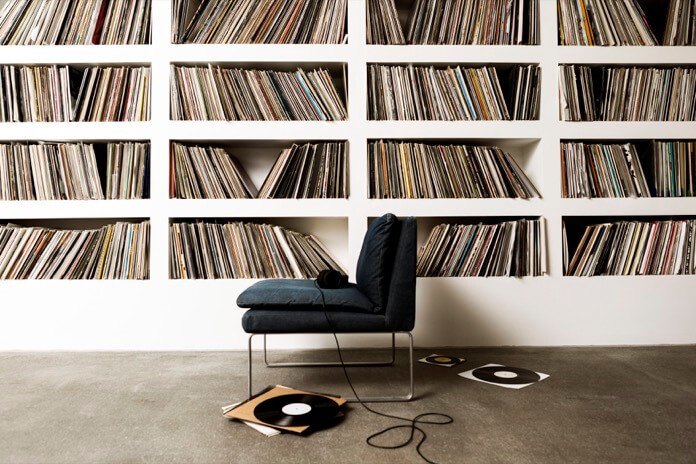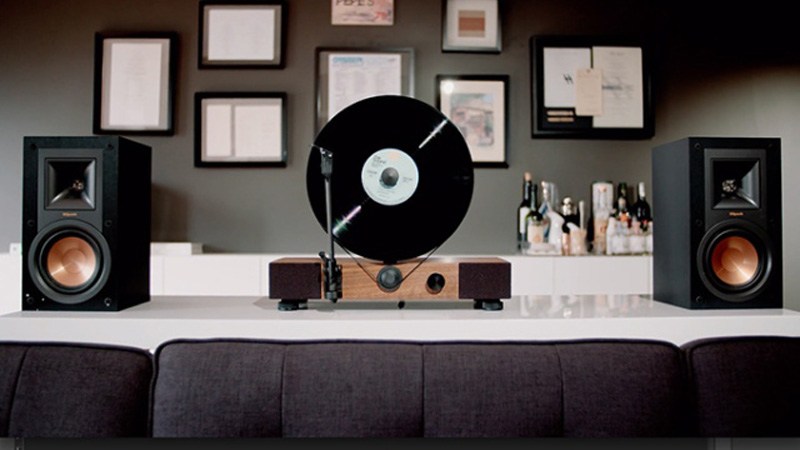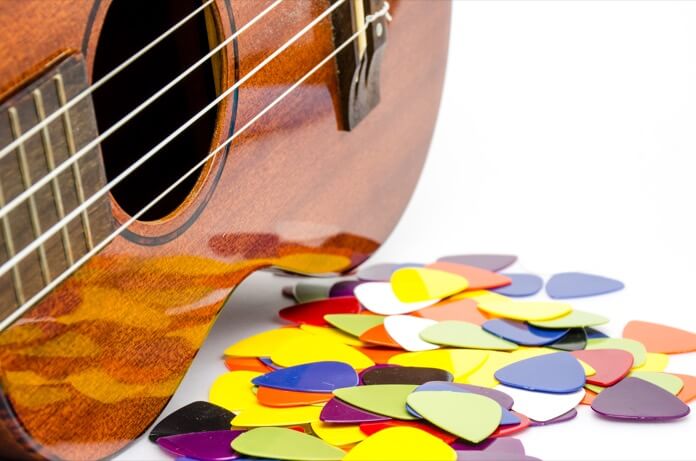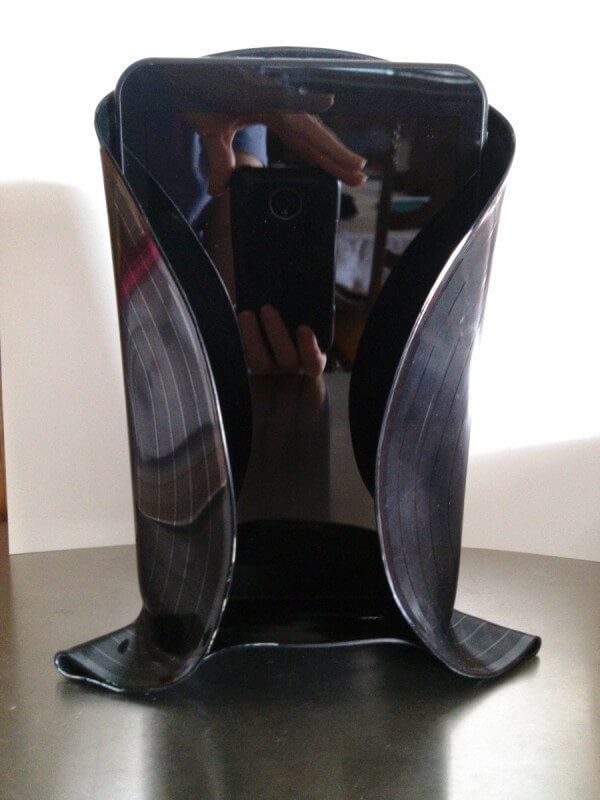Let’s take a second to do a little exercise, shall we?
Imagine yourself strolling down the street, by your favorite bar. You have your new dress or suit on, and you are feeling fantastic. You are just casually walking and daydreaming.
Something interrupts your stream of thoughts. You hear beautiful music, coming from your favorite place. You are a little confused, because it sounds much better than a regular song from the radio, almost like someone is singing live. It is possible – but on a Sunday afternoon? You highly doubt it.
The sound is so rich and colorful that you can already imagine Aretha Franklin sitting by the bar and singing from the top of her lungs. For a moment, you stop and listen. Then, the magic happens. You hear the familiar crackling sound, and you realize, someone is playing a vinyl record!
Your heart is full. You thought the world started to forget about those magnificent things, but it seems like it didn’t.
Vinyl records are overtaking the world once again. Their popularity begins to rise from the ashes due to increased interest in retro style. Many people believe that vinyl does, in fact, sound better than any other sound medium. At this point, you may disagree, but if you give it a chance, you might be surprised. People usually fall in love with it on a first listening.
Today we are here to offer you some insight on the history of vinyl, how does it work and what to do if you start getting addicted to its sound. We’ll be going through questions that riddle beginners and enthusiasts at the same time – where to buy records and how to choose the right gear. So, whatever your level of involvement with good old LPs might be, you’ll find this article interesting. Keep reading for more information.
What is Vinyl Records?

A vinyl record (gramophone record, or simply record) is an analog sound storage medium. It looks like a flat disc that has an inscribed modulated spiral groove, starting near the periphery and ending near the disk’s center. Records were the main medium for commercial music reproduction during the 20th century. They became popular in the 1900s, and they held their place as a primary sound medium until the late 1980s when digital media began to happen. Still, vinyl records remain the favorite choice for many audiophiles, especially electronic dance and hip hop artists.
There are few types of gramophone records – 33 1/3 rpm record (LP); EP or 16 2/3 rpm record, 45 rpm record, and 78 rpm record. LP and EP are acronyms for Long Play and Extended Play, which referred to the usual number of songs on each side. The numbers you can see in the name of a vinyl type refer to their rotational speeds in revolutions per minute (rpm). LPs are usually 12-inch records, while EPs are 7”.
Edouard-Leon Scott built the device known as phonautograph in 1857. This was developed to examine the characteristics of sounds, but it also recorded the sound. Later, in 1877, Thomas Edison developed this device into a machine, the phonograph, that was capable of replaying the recordings made. The recordings were made on tinfoil. The initial intention was to use them for office dictation. Edison’s machine was developed further by Edward Gilliard.
Emile Berliner invented lateral-cut disc records in 1888. A few years later, he began marketing disc records under the Berliner Gramophone label. The Edison Blue Amberol Record was introduced in 1912, with a more resilient playing surface and playing time of 4 minutes. By the end of 1918, the patents for the manufacture of lateral-cut disc records expired, opening the field for other companies to produce them, causing disc records to overtake cylinders in popularity.
How Is Music Stored On Vinyl Records?

If you want to understand how is the music stored on vinyl records we have to take another look at history. During the 19th century, scientists were preoccupied with the idea of sound waves, how they move through the air and how are our ears able to hear them.
As we said, Édouard-Léon Scott succeeded to re-create the ear drum by attaching a stylus to a thin membrane. That was a significant step forward. He traced sounds onto paper and glass. Later, during the 1870s, Edison successfully recorded the human voice and played it back. His idea was to attach a thin membrane to a needle touching a cylinder covered with tin foil. Through this mechanism, sound waves hit the diaphragm and moved the needle, which etched the vibrations into the cylinder.
While Edison was working on his project, Berliner did a similar thing. Instead of a cylinder, he used a flat disk and two needles. One needle was cutting three-dimensional grooves directly into the disk, while another needle was reading the grooves by running along them, producing a sound that was amplified by a horn or cone.
All of this lead to the invention of the gramophone in 1887. The music is recorded onto a master and then pressed into vinyl. To press recorded sound into vinyl, the record needs to be cut. This is done by using a signal which forces the cutting needle to wiggle in the soft lacquer. Next step is to coat the lacquer in metal via electrolysis. This makes it hard enough to be a stamper. Then, this compound is used to make a metal negative which is used to stamp the globs of hot vinyl into records.
After the vinyl record gets into your hands, the question is how does the music come off it? Record players have a stylus, made from diamond or sapphire. The stylus is attached to a tone arm. All o the terminology may be confusing, but the tone arm is just a name or that thing you pick up and move to start playing a record.
Of course, the sound is carried through the tone arm to a cartridge containing coils in a magnetic field. These coils are responsible for taking the vibrations and amplifying them electronically through speakers.
So, if somebody asks you how is music stored on vinyl records, you can simply say that sound is recorded and pressed into them, but you have to remember there is the whole complex mechanism and story behind that simple answer.
10 Reasons Why Vinyl is better than Digital Format

You might hear people say how vinyl sound is much better than digital format. It is warm, nostalgic and it has some unique fuzziness no one can explain. Still, many people disagree, they complain about the quality of the sound and the loudness. There are specific advantages related to both vinyl and digital format. Here, we’ll be listing the top benefits of vinyl according to records enthusiasts.
1. Lossless format
Vinyl is the only playback format that’s fully analog and lossless. This means you just need a decent gramophone and you’re going to get a full-fidelity listening experience. It’s less technical than digital format.
The analog format means that artist has a possibility of transporting their music from magnetic tape to LP and finally to your speakers or headphones without the complications of digital conversion. You get exactly what the artist intended to give you.
2. The warmth of the sound
What people find special about vinyl records is this magical factor. Because of how it was made and the fact that there is nothing digital about it, vinyl sound offers the experience, which is very close to listening live music. It’s mid-range-y and mahogany warm. That’s the sound that flatters every musical instrument.
3. Loudness limits
It’s the truth. Vinyl sound can never be as loud as digital one. Many people think this is a huge disadvantage of records. But let’s take a look from a different angle. Digital music engineering often goes over the top with the volume. They give their best to make music louder and louder. Unfortunately, this leads to fatiguing, hyper-compressed songs that lack the dynamics and textures that give recordings their depth and vitality.
Vinyl’s volume is dependent on two factors: the length of its sides and depth of its grooves. This means the more songs on the vinyl – the quieter the sound. If you listen to the record with the long album and then the one with only a single on it, you’ll notice the remarkable decibel difference.
4. Surface noise
Here’s another thing that can be seen as benefit and disadvantage at the same time. Dust particles tend to get stuck in the grooves of the record, or even pile up there. This causes crackles and ticks that are present and audible no matter how well you clean the record.
Also, vinyl records have a subtle underlying hiss generated by the needle that moves around the surface. On the other hand, CDs and other digital format are not affected by surface noise, because they use light beams to read the musical data.
Vinyl lovers will tell you that the surface noise is what makes vinyl special, it gives it that nostalgic, sensual tone that people are often aiming for. On the other hand, digital format fans will disagree, and tell you that it contaminates the sound’s quality. So, it is up to you to decide if you like it or not.
5. Focus on music

You will not find yourself in the situation to listen to the record sporadically. You will not just press the button and let anything play while you cook or while you are driving your car.
Listening to the records is more elaborate, it is the whole process. You have to choose the record, to put it on, to turn it at some point. You put the record on when you really want to LISTEN to the music as the primary activity.
Good music sometimes deserves your full attention.
6. Availability
This factor is not that much about the sound, as it addresses the topic of having a collection. Many great records are still not available on CD, which is enough to justify vinyl by itself.
If you are a collector, you know how frustrating it can be if you decided to get something and you find out it simply doesn’t exist on the medium you are collecting. Of course, you can find almost any song on Youtube or somewhere else on the internet, but you will never physically own it.
7. Cover art
Another thing unrelated to the sound of the record. LP sleeves are big enough that you can really appreciate the cover artwork. This completes your experience. You have the music, just as the artist wanted you to have it and you can look at the cover at the same time, and understand its meaning. Even if the record dies, you can keep the cover and place it on your wall for decoration.
8. Records culture

This factor is also related to the topic of having a record collection. People who collect or play records seem more smooth and cool than others. They have a particular appreciation for evergreen music and authenticity of the author.
Vinyl has that magical power of connecting people with similar interests. If you are a true collector, you have to be in contact with a lot of people around the world if you want to maintain the high-quality collection. After all, records look much better than CDs on your shelf.
9. Time constraints
Vinyl records have limited number of songs on them. Believe me that is a great thing. Albums usually offer four or five songs on each side, which is the perfect amount in one sitting for any artist. Once you listen to the whole thing, you’re nearly always ready to move on to something else. You get intro, different moods and the closure all in one package.
CD’s increased capacity seems like a good thing at first, but it means that inferior songs will also find their place on the album, decreasing the overall quality of an artist’s release as a result.
10. Longevity
It’s a fact. Your dad’s records from 40 years ago still sound as good as back then. Your CDs from 10 years ago, not so much. Of course, many of them still work perfectly, and it depends on how you store them and so on, but CD’s still scratch more easily.
How to Maximize Sound Quality from the Vinyl Records?
1. Where to Buy Vinyl Records?

If you are at the beginning of making a records collection, or you are an experienced collector who needs more ideas on where to buy the LPs he’s missing, checkout top 44 online vinyl record store at here.
2. Take a record player

Your remarkable vinyl collection won’t be of much use if you don’t have a record player or a turntable. Before you decide to purchase one, you should know what it is, what are your needs and how much money you plan to spend on it.
Record player or turntable is basically a device made for mechanical recording and reproduction of a sound. You play your vinyl records on it. Turntable consists of following parts:
- Plinth (base) – this is the foundation which supports the rest of the components. It usually has feet to ensure stability.
- Platter – This is the rotating component upon which the record spins. You should look for devices with the heavier platter because it increases vibration.
- Tonearm – The arm which allows the needle to make contact with the vinyl while it spins. It maintains the sound and speed consistency.
- Cartridge/Stylus – the stylus is the needle, and a cartridge is the housing that supports the stylus. It is important that you buy a turntable that has its stylus and cartridge made of high-quality
First, decide on the purpose you are purchasing a turntable for. For example, if you want the professional DJ turntable, you will be looking for different features than if you’re finding best portable turntable or best record player with speakers . If you are fan of record player, you can’t miss these vintage record players.
At last, consider the price range. You can get a decent record player even if you spend less than 100$. However, more money will get you better quality. If you spend around 300$ you can get the perfect device for a beginner. However, if you are an experienced audiophile, I recommend you to look for the turntables in the price range from 500$ or even 800$ and above.
3. Tips to Get the Best Sound from Record Player
Clean your vinyl

If you want to improve the sound of your records, keep them clean. No excuse. Records that are kept free of dirt, dust, and oils from one’s fingers will sound much clearer. For starters, buy a good record cleaner for deep cleaning and a carbon fiber vinyl brush to remove static. This will also pick up dust or lint that gets dragged through the grooves by the needle. Give your records a quick brush every time before and after playing. It’s simple as that.
Don’t use harsh abrasives. Safety should be your number one priority. Treating your records right won’t only give you the better sound, but it will make your vinyl last longer.
Choose the right cartridge

Having a cartridge, stylus, and tonearm made of high-quality materials is essential. It might cost you more money when you first buy it, but it is better for you in the long run. Cheap record players with ceramic cartridges and heavy-tracking plastic tone arms will cost you your precious records. Turntables that are even slightly more expensive might give you much better sound and longer life for your vinyl.
Store your records properly

The best place for your records is on your turntable but if you’re putting them away store them vertically. Never lay them on top of each other. Putting your vinyl records horizontal will cause them to warp.
Of course, keeping your records vertically can be tricky. You should find the right kind of container to hold them. Wine crates can do a pretty good job.
Sleeves will give your vinyl records extra protection, keeping them away from dust and dirt. Unfortunately, some sleeves become damaged over time. If you notice that some of your sleeves start wearing off, just buy a new one. This is a small cost that will make a big difference. When choosing the right sleeves, always go with the anti-static ones.
Find the right balance
People often think that we are going over the top when we say that the balance of the tonearm matters, but it really does. If you want to get a better sound, this is one of the crucial things to do. Setting the tracking weight and balancing your tonearm may offer you much better experience and it will save both your needle and your records, at the same time. Just be gentle and patient, it might take you a while until you find the perfect angle but it will pay off.
Shop in old school record stores
I am not sure if this is the myth but I am the vinyl collector, and I believe it. Records you buy in small shops or specialized online stores sound much better than the ones you buy in big general shops like Tesco or Amazon.
Maybe it’s all about the year of manufacture or the story that comes with the vinyl from the specialized shop. Maybe it’s about the process of choosing and other enthusiasts offering their recommendations. However, record stores have a soul, and a vinyl you buy there brings a part of that soul back to your home. If you want a better sound, choose where you shop.
4. Additional gear

Fortunately, from the enthusiast’s standpoint and unfortunately for your wallet, the story doesn’t end with buying a good turntable. There are many additional parts you’ll need if you want to achieve the authentic and high-quality listening experience.
Putting together a turntable setup is a simple process. However, it has more steps than you would expect. This is the gear you should also shop for:
Phono preamp – Turntables produce PHONO output signal, which needs to be converted into a line level (AUX) signal. If you don’t have this piece of equipment, your turntable won’t work with stereo systems, computers, and speakers. Phono preamp does this job for you. Some turntables come with a built-in preamp. For example, if your record player has a USB output, it also has the preamp.
Amplifiers – The stereo power amplifier is the electronic device which increases the low-power audio signal which comes from your pre-amp or record player and sends it right into the loudspeakers. Depending on whether you own a separate phono pre-amp in your set, you’ll need to search for a power amplifier that has a built-in phono stage, or for one that does not. If can’t find good device then you get some all in one turntables at here.
Speakers or headphones – You should buy speakers or headphones (whichever you prefer) that are vinyl friendly. They should be able to allow as much detail through the hi-fi chain as possible. Your speakers should have high-quality amplifier if you want to get the best sound possible.
Turntable Accessories – These are not necessary. They are just the part of the record culture and fashion. Some of them will undoubtedly improve the sound of your records, like cartridges or tonearms for example, but some are here just for your fun. However, you could benefit from each and every one of them differently.
9 Useful Ideas to Recycle Vinyl Records
Records do damage after some time. They have a long life, but they are not indestructible. Friction causes heat, which softens plastic and makes it easy to deform. Of course, if you don’t clean them or store them right they’ll become useless faster than you expected. Also, accidents happen, the record falls out of your hands and breaks on half.
For a collector, it is a great loss. However, there are many ways how you can recycle your broken records, and some of them are listed below.
1. Make beautiful bookends

If you love books as half as you love records, you’ll find this project interesting. Tip: You’ll need a heat gun.
2. 3D butterflies

If you are a little creative, this shouldn’t be a problem for you. It makes a great wall decoration.
3. Circular pendant

Here’s a way for you to treasure the lost vinyl forever and wear it around your neck, or give it to someone special. Even if you don’t own any power tools, you can still cut simple shapes out of vinyl records.
4. Vinyl Clock

Simple and retro at the same time. It will look great on your wall right next to your record shelf. Get creative and use the guitar picks to mark the hours. It is a chance to add some color to make a contrast to black vinyl.
5. Desk lampshade

If you have an old lamp that needs a lampshade or just a makeover, you can use your scratched records. Of course, vinyl is too small to make a regular lampshade out of, but it’s just the right size for a desk lamp.
6. Guitar hanger

Is there a better place for your guitar than next to your favorite record? I highly doubt it. Be sure to make them stable enough.
7. Guitar pick

How cool would it be to have a guitar pick made from a recycled record? It may be too soft or too thin for you, but it is good at least for the practice or as a good luck charm.
8. The purse for all generations

No woman will ever have enough bags and purses. If you have an old bag that also needs recycling or you want to make an entirely new one, vinyl will serve you right. It will give your purse nice and sturdy sides.
9. Tablet holder

Another practical thing you can make, similar to the bookends we mentioned. It will look awesome, and as a bonus, you’ll always know where your tablet is.
Conclusion
Let’s take another moment to go back to the story from the beginning. How did you feel when you imagined hearing a record playing from your favorite bar?
It was delightful, wasn’t it? Well, you can experience that same feeling every day in your own home! We gave our best to make vinyl records closer to you; we told you where to buy them, how to choose the right equipment and how to take care of them properly. The rest is up to you.
If you decide to become a record collector, we are sure you will find your place in our colorful community. However, pay respect to the vinyl, it gave the world much more than people realize.
If you liked our article, you can hit a like or share it with your friends who might be interested in vinyl.

